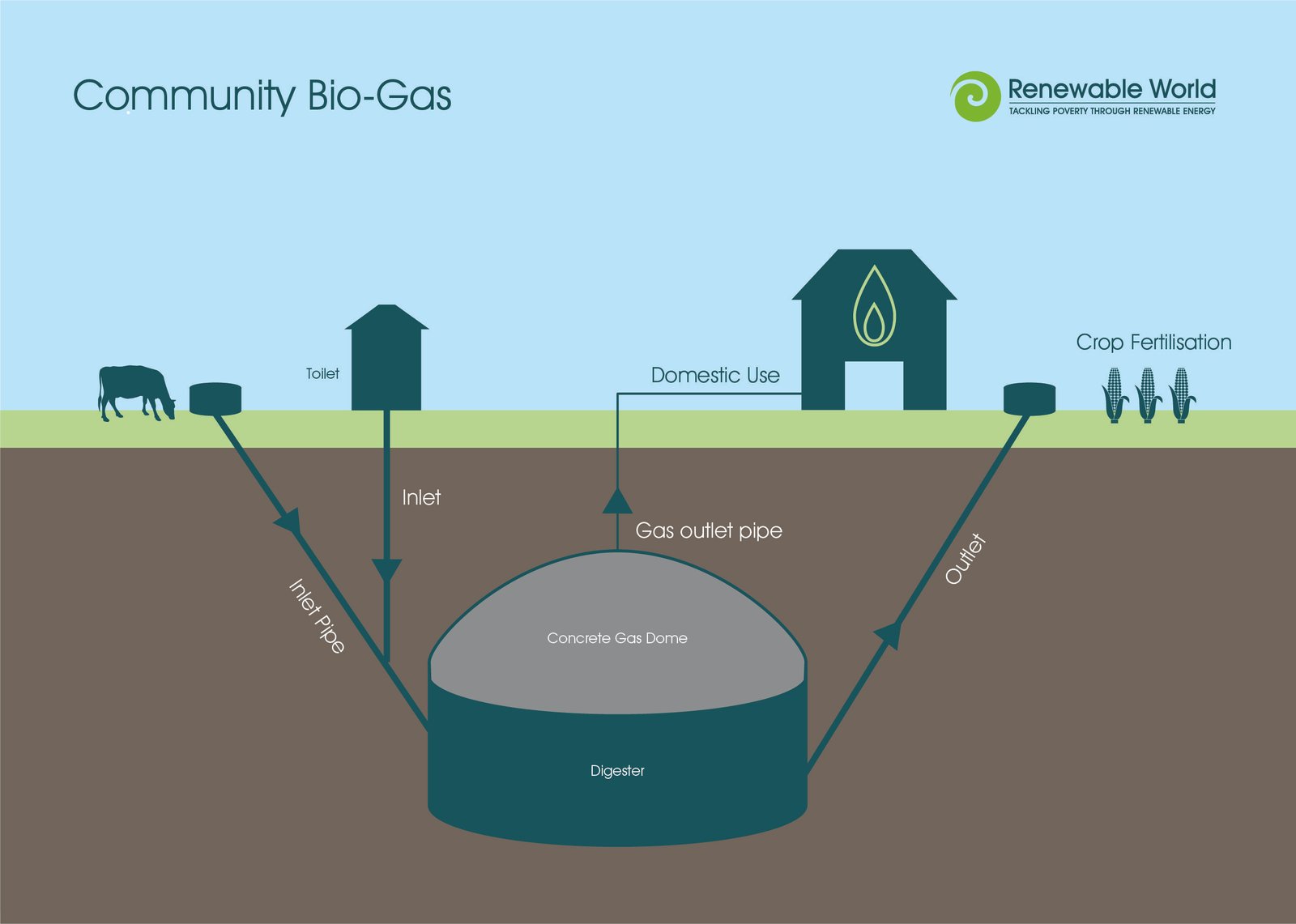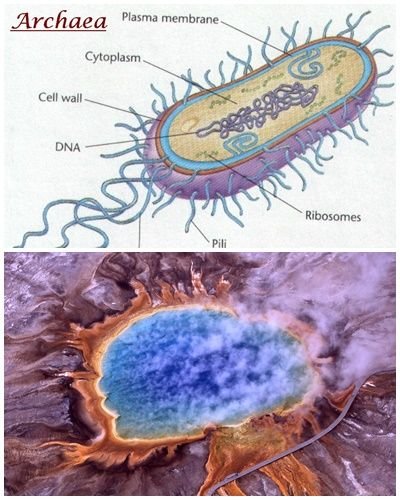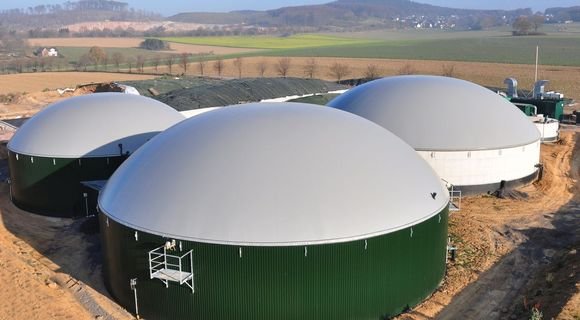I received doubt messages about biodigester. It is a way to generate energy from biomass, whose operation is this post`s subject.
I recommend that also reads the post about energy by biomass.
Energy generation by biomassClick here
What it is and how does a biodigester works?
Organic material is stored inside a chamber and inside that is produced biogas as fuel. In addition to that, produce fertilizer for crops. There are different channels to outlets of biogas and fertilizer.

In rural area, organic matter is composed by animal and agricultural waste. This is a bigger biodigester to make use of organic trash from cities and industries.

Anaerobic production of biogas
Anaerobic means without oxygen. Biogas is formed by 50% to 75% of methane (CH_{4}), 25% to 50% of carbon dioxide (CO_{2}) and small quantities of hydrogen (H_{2}), hydrogen sulfide (H_{2}S), ammonia (NH_{3}), oxygen (O_{2}) gases, in addition to water (H_{2}O). Biogas production is divided in following stages, which occur simultaneously.
Hydrolysis
Organic matter have complex compounds: proteins, carbohydrates and lipids. In this stage, complex compounds are broken in simpler molecules like sugars, amino acids and fatty acids. The former molecules are broken by hydrolytic bacteria which produce enzymes (lipases, proteases and amylases) to execute the following chemical reactions.
C_{12}H_{22}O_{11}+H_{2}O\rightarrow C_{6}H_{12}O_{6}+C_{6}H_{12}O_{6}
- C_{12}H_{22}O_{11} = sucrose.
- C_{6}H_{12}O_{6} = glucose and fructose. Although have the same chemical formula, are different molecules.

C_{57}H_{104}O_{6}+3H_{2}O\rightarrow C_{3}H_{8}O_{3}+3C_{18}H_{34}O_{2}
- C_{57}H_{104}O_{6} = fat called Triolein.
- C_{3}H_{8}O_{3} = glycerin or glycerol.
- C_{18}H_{34}O_{2} = oleic acid.
C_{4}H_{6}O_{3}N_{2}-R1-R2+H_{2}O\rightarrow C_{2}H_{4}O_{2}N-R1+C_{2}H_{4}O_{2}N-R2
- C_{4}H_{6}O_{3}N_{2}-R1-R2 = di-peptide protein.
- C_{2}H_{4}O_{2}N-R1 and C_{2}H_{4}O_{2}N-R2 are amino acids.
Acidogenesis
In this phase, fermentative bacteria convert sugars, amino acids and fatty acids in short chain acids and other substances.
4C_{3}H_{8}O_{3}+2HCO_{3}^{-}\rightarrow 7CH_{3}COO^{-}+5H^{+}+4H_{2}O
- HCO_{3}^{-} = bicarbonate ion.
- CH_{3}COO^{-} = acetate.
C_{5}H_{9}NO_{4}\rightarrow CH_{3}CH_{2}COOH+2CO_{2}+NH_{3}+2H_{2}
- C_{5}H_{9}NO_{4} = glutamic acid.
- CH_{3}CH_{2}COOH = propionic acid.
3C_{6}H_{12}O_{6}\rightarrow 4CH_{3}CH_{2}COOH+2CH_{3}COOH+2CO_{2}+2H_{2}O
- CH_{3}COOH = acetic or ethanoic acid.
Many bacteria genera make acidogenesis.
Acetogenesis
This phase is characterized by production of acetic acid, hydrogen and carbon dioxide from organic acids and other acidogenesis molecules. Some reaction examples of this phase made by acetogenic bacteria.
CH_{3}CH_{2}COO^{-}+3H_{2}O\rightarrow CH_{3}COO^{-}+3H_{2}+H^{+}+HCO_{3}^{-}
- CH_{3}CH_{2}COO^{-} = propionate, came from propionic acid.
- CH_{3}COO^{-} = acetate, acetic acid’s ion.
CH_{3}CH_{2}CH_{2}COO^{-}+2H_{2}O\rightarrow 2CH_{3}COO^{-}+2H_{2}+H^{+}
- CH_{3}CH_{2}CH_{2}COO^{-} = butyrate, came from butyric acid.
2CH_{3}(CH_{2})_{3}COO^{-}+6H_{2}O\rightarrow 5CH_{3}COO^{-}+6H_{2}+3H^{+}
- 2CH_{3}(CH_{2})_{3}COO^{-} = valeric acid’s ion.
In this step, it is important to control hydrogen concentration. If it is too high, don’t have compound conversion in acidogenesis, therefore, increases quantity of organic acids. Consequently, there is no methanogenesis to biogas production. Hydrogen production reduces local environment’s pH.
Methanogenesis
Finally, methane CH_{4} is produced in this stage, combining acetic acid CH_{3}COOH, hydrogen H_{2} and carbon dioxide CO_{2}.
CO_{2}+4H_{2}\rightarrow CH_{4}+2H_{2}O
CH_{3}COOH\rightarrow CH_{4}+CO_{2}
Methanogenic microorganisms are from Archaea kingdom or domain. Acetoclastic methanogens produce methane from acetic acid, while hydrogenotrophic make it from hydrogen and carbon dioxide.

Sulfetogenesis
A biodigester also produces sulfur, which came from organic matter. To use biogas as energy source, sulfur concentration must be reduced, because hydrogen sulfide causes corrosion in metals and motors. Exist many sulfur removal methods which will be shown in another post. In sulfetogenesis, sulforeductive bacteria transform sulfate and sulfite into sulfide.



